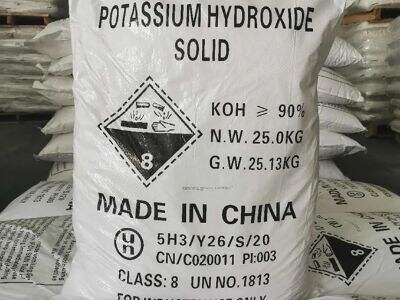KOH vs NaOH: KOH and NaOH are two great chemicals that sensibly contrast with regards to their responsive conduct and solvency in water. They are also used in many different industries for different applications, and you need to know the dangers and precautions of these materials while using them. We will discuss some differences between potassium hydroxide and sodium hydroxide so you can get a good understanding of what they actually do.
Reactivity and solubility differ between potassium hydroxide and sodium hydroxide
Both potassium hydroxide and sodium hydroxide are strong alkali chemicals that can react violently with acids. A step up from sodium hydroxide, but potassium hydroxide is even MORE reactive than lye by a hair. This makes K+ a stronger nucleophile than Na+, and, therefore, KOH more reactive toward nucleophilic attack than NaOH.
Potassium hydroxide is also more soluble in water than sodium hydroxide (1d) because of formation of hydrogen-bond with oxygen atoms. It also suggests that potassium hydroxide is more soluble in water, meaning it will easily dissolve to form a clear solution while sodium hydroxide might take awhile to completely dissolve.
Considering Applications of Potassium Hydroxide and Sodium Hydroxide Across Industries
Both potassium hydroxide and sodium hydroxide have multiple applications in several industries. It is a popular ingredient in the manufacture of soaps and detergents. This ORGANIC CHEMICAL is also utilized in the food sector for such as making sodas and processing foods.
By contrast, sodium hydroxide is widely used in the manufacture of paper, textiles, and food
Medical – It is used in medicine to synthesize drugs and treatment-water which helps adjusting pH of water.
Suggesting dangers of handling potassium hydroxide versus using sodium hydroxide
Sodium hydroxide is caustic and can cause burns if it comes in contact with skin or eyes. One must always be in a protective covering like gloves on hands, goggles for the eyes to avoid any sort of accidents.
Furthermore, both INORGANIC CHEMICAL release toxic fumes when combined with other substances so it is important to either be working in a ventilated area or not use them. Spills need to be cleaned up immediately and the chemcials disposed of properly.
The difference in acidity and alkalinity of potassium hydroxide vs sodium hydroxide
Both potassium hydroxide and sodium hydroxide are alkaline substances with a pH greater than 7. But potassium hydroxide is even more alkaline than sodium hydroxide, so it can be used to better neutralize acids.
Slightly acidic as its lead counter-part, Caustic soda Na(Oh) is contrast to K OH. Because of this, Sodium bromide liquid may not be as good as potassium hydroxide at neutralizing acids.
Assessing environmental impacts of employing potassium hydroxide versus sodium hydroxide in production steps
Potassium hydroxide and sodium hydroxide have a relatively low environmental impact. Both can be harmful to aquatic life if released into water bodies, so it is important to take care when storing and disposing of these chemicals.
Table of Contents
- Reactivity and solubility differ between potassium hydroxide and sodium hydroxide
- Considering Applications of Potassium Hydroxide and Sodium Hydroxide Across Industries
- Suggesting dangers of handling potassium hydroxide versus using sodium hydroxide
- The difference in acidity and alkalinity of potassium hydroxide vs sodium hydroxide
 EN
EN
 AR
AR
 BG
BG
 HR
HR
 CS
CS
 DA
DA
 NL
NL
 FI
FI
 FR
FR
 DE
DE
 EL
EL
 HI
HI
 IT
IT
 JA
JA
 KO
KO
 NO
NO
 PL
PL
 PT
PT
 RO
RO
 RU
RU
 ES
ES
 SV
SV
 TL
TL
 IW
IW
 ID
ID
 SK
SK
 VI
VI
 HU
HU
 TH
TH
 TR
TR
 MS
MS
 GA
GA
 UR
UR
 BN
BN
 GU
GU
 LA
LA
 MR
MR
 PA
PA
 TA
TA
 TE
TE

